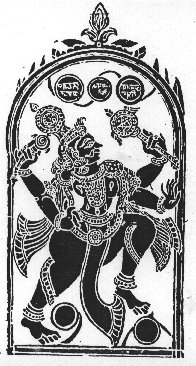Gatekeeper in Indian Art
Gatekeeper in Indian Art
by K. L. Kamat
First created: August 15, 1997
Last updated: December 07, 2024
More often than not, the Hindu temples have painted or sculpted guardians at the entrance. Continuing our series on The Arts of India, Dr. Kamat takes a look at the gatekeepers as depicted in various art forms.
-- Ed.
It is very common to erect painted or sculpted guardians or doorkeepers (known as the Dwarapakalas) at the entrance of the Hindu and Jain temples in India. Not only the main entrances, these permanent doormen protect secret entrance, minor entrance, and sometimes the window doors. If the sanctum sanctorum is multi-storied, then all the doors are also protected. Throughout India, one can see decorated doormen outside of private buildings and luxury hotels as well. The doormen outside the temples are typically great devotees or strong men. However, I have noticed personalities of the period as well as women shown as protecting the doors.
© K. L. Kamat

Four Armed Lord Vishnu
Monochrome Kavi artwork, Western India
Hanuman and Garuda (see a picture of Garuda) are the most common guardians in Hindu temples. In a temple of Bicholi, the Hanuman is flying in the air with a flag in one hand and gada (club) in the other. In a temple of Balalagram, these monkeys remind one of the Egyptian mummies. In the village of Shirali, Hanuman is punishing the demon and the Garuda is punishing the evil cobra.
The Tamilnadu State in South India, one can come across a variety of strong men, most beautifully built and artistically painted to keep the undesirable forces out. Even the commonest temples in Madurai have the painted Dwarapalakas outside of them.
The credit of having the sun and the moon as its doorman belongs to the Narayani temple in Kumta. The spectacular Kavi mural (see -- Kavi Art) depicts seven horses pulling the chariot of the sun God. Many murals in Karnataka depict doormen of the period and can be used to study attires of the corresponding era. In Awarsa, apparently they had entertainers as doormen! In another temple, the doorman's attire resembles that of the present day Goorkhas. Many of the doormen are shown with rumals (turbans -- see The Turbans of India), a tradition that has continued till today.
The Jain architects have gone in for beautifully sculpted serene Dwarapalakas in consistence with the mood of their Basadis and their non-violent faith. Jain monuments provide a great source of sculptural wealth for students of art and history alike.
As the western influence percolated India, the doormen are given pants, shirts, and hats. Some guardians are given guns. It is interesting to watch some men wearing part Indian and part European clothing.
Rarely there are some ladies are shown protecting doors. In a temple in Honavar, celestial women (Kinnaris -- with a bird-like body, but with breasts) playing musical instruments are shown at the entrance. It can be recalled that till recently it was women who fanned the sacred statues on the West Coast of India.
It is no doubt that the doormen, as the greeters of the temple or house provided the first impression to the visitors and the artists and architects of Indian have take pains to make the Dwarapalakas stand apart. So the next time you visit a temple, do take time to notice and appreciate the Dwarapalakas of the temple.
![]()
Gatekeeper in Indian Art
- Carved head of a Dwarapalaka (doorman)
- Decorated Doorman
- Gatekeeper of a Luxury Hotel
- Hoysala Style Gatekeeper
- Kadri Temple Features a Diety as a Doorman
- Marvels in Monochrome
- Muscular watchman (Dwarapalaka), Aihole
- Perhaps the Outfit of a Watchman
- Portrait of a Watchman
- "Sacred Area. Keep Out"
- Small Temple, Huge Guardians
- Temple Bouncer (Doorman)
- Temple Guard with Gun and Daggers
- Temple Guardian -- from a wall mural in Karnataka
- Vishnu as Guardian
- Woman Doorkeeper from a Goan Temple
See Related Topics at Kamat's Potpourri:
- Hinduism Potpourri -- topics on Hindu culture
- Jainism Potpourri -- topics on Jain arts and monuments
- The Arts of India -- various forms of arts from India
- The Temples of India -- lengthy discussion on the history and artistic styles of great temples of India.
See Also:
-
Search for pictures of Gatekeepers at Kamat PictureSearch
-
Search for pictures of Temple Art at Kamat PictureSearch
Merchandise and Link Suggestions
- Amma's Column -- The History, Mystery, and Diversity of India, now as a blog
- Explore More: dwar, hindu, art, gatekeeper, temples in india, indian art, gatekeeper, exhibition

